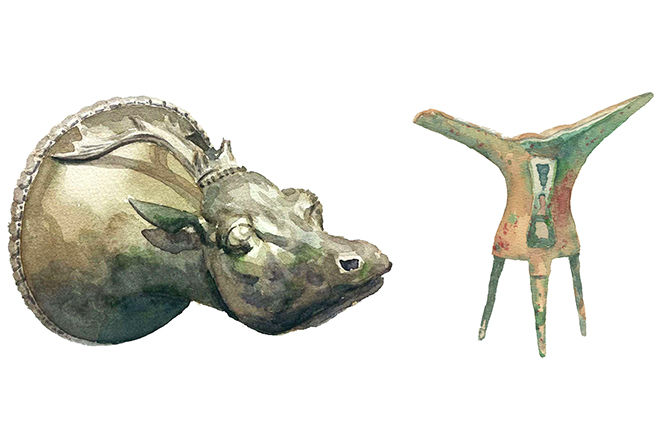Civilizations and arts in cultural relics

Bronze rhyton & jue painted by Guo Haichao
Through cultural relics, we can feel the pulse of ancient civilizations, revealing unexpected “telepathic connections” where we once saw isolation. The endless exchanges and connections between different civilizations, as well as within the same civilization across different eras, demonstrate that communication, exchanges, and fusion in symbiotic development are intrinsic to the evolution of civilizations and the arts.
Resonance of civilizations
Spatial constraints cannot interfere with “telepathic connections” between civilizations. As is frequently demonstrated in museum exhibitions where one often encounters peculiar artifacts, such as two cups: one, a 1st-century antler-shaped rhyton unearthed from the ruins of ancient Pompeii; the other, a bronze jue (tripod vessel) excavated from the Erlitou site in China. These two unique bronze vessels from the East and the West were both used in ritual ceremonies, belonging to different civilizations yet serving similar functions despite being unearthed in distant locations. The two artifacts come from the ruins of ancient Pompeii in Italy and the Erlitou site in China respectively. Pompeii, situated at the southern foothills of Mount Vesuvius, was once beautiful and prosperous. Pompeii fell to the ancient Greeks and the Samnites before becoming a Roman colony, after which it developed rapidly to become the second largest city in the Roman Empire. In 79 CE, Pompeii was abruptly engulfed in volcanic ash during the eruption of Mount Vesuvius, with the peaceful Sarnno River at its feet bearing witness to the tragic event. In 1748, the ruins of ancient Pompeii were discovered. When the vivid murals, exquisite utensils, and magnificent buildings were revealed once again, people couldn’t help but marvel at the prosperity of the past and feel that civilization seemed to have been frozen in that moment.
The Erlitou site has some of the earliest bronze ritual vessels, a bronze yue (axe-shaped object) symbolizing the power of the ruler of the state, and exquisitely crafted jade artifacts have been excavated. Only when a state had been established would such highly artistic objects be used, thus their discovery strengthens our certainty regarding the history of the Xia Dynasty. It can be said that these artistic relics testify to the highly developed civilization of etiquette and institution of Xia Dynasty (c. 2070-1600 BCE). The Erlitou site locates on the Yiluo Plain (or Luoyang Plain) within the Yellow River system, with the Songshan Mountain to the south and the Taihang Mountains to the north. Therefore, Luoyang has historically been referred to as “Zhong Guo (China),” “Zhong Tu (the center of the land),” and “Zhong Zhou (the center of the continent).” The Erlitou site’s considerable geographical advantages advance the extensive civilizational influence, ultimately spreading throughout the country. This illustrates that civilization transcends geographical constraints, quietly interacting with the outside world.
Chinese characters & beauty
The continuation and dissemination of civilization requires certain important carriers. Cultures and arts serve as indispensable forms and content among others. Written characters record and carry on civilizations. Ancient writing systems and civilizations share an indispensable connection. Chinese characters represent one of the oldest independent writing systems still in use worldwide. From oracle bones, bronze, silk, and bamboo slips to paper and electronic screens, writing has transcended various carriers, enduring the passage of time while passing on the cultural heritage. The evolution of the carrier not only signifies changes in the function of writing as a vehicle for civilization but also enables unique artistic beauty. To this day, Chinese characters continue to embody the profound depths of Chinese culture through the art of calligraphy, ceaselessly showcasing the roots and enduring legacy of China’s fine traditional culture to the world.
Timeless & boundless
The charm of art lies in its timeliness and ability to break through the limitations of time and space. In 1943, Zhang Daqian’s painting “Water-Moon Guanyin (Avalokitesvara)” set a record-breaking auction price not only due to Zhang’s artistic prowess but also because of the artwork’s rich artistic history. This work is a replica of the mural in Cave 2 of the Yulin Grottoes from the Western Xia Dynasty (1038-1227). Zhang Daqian combined the image of the Water-Moon Avalokitesvara from the Western Xia era with the landscape and figure painting styles from the Ming Dynasty (1368-1644) and Qing Dynasty (1644-1911), creating a blend of modern and traditional artistry. Elements from the Tang Dynasty (618-907) in form, Song Dynasty (960-1279) and Yuan Dynasty (1271-1368) in spirit, Ming and Qing techniques, and modern thoughts, though not contemporaneous, converge in this artwork. The imagery of art conveys information about its era, demonstrating that artistic expression can transcend temporal constraints, while cultural fusion is an ongoing process. The arts often encounter collisions of time and space in its transmission and dissemination of heritage, creating the most vivid rhythms through such collisions.
Guo Haichao is from the National Museum of China.
Edited by ZHAO YUAN
